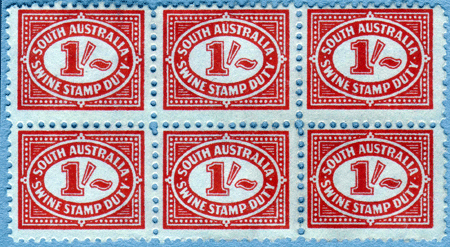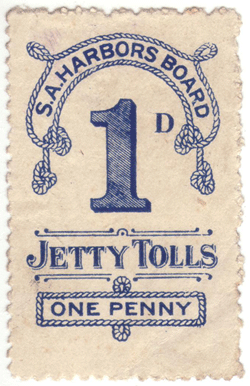JUDGING SOUTH AUSTRALIAN REVENUE STAMPS 1886-1965
AT FIP WORLD EXHIBITIONS
Dave Elsmore
This is the fifth in the series of ‘Let’s Educate the Judges’ in evaluating the exhibits of the Australian States Revenue and Railway Stamps.
When judging a South Australian revenue exhibit there are several references available to the judge. W. Craig has published the ‘The Revenue Stamps of South Australia’ 1993, which is in bad need of an update (I have been told it’s still 3 years away), and several excellent articles in the ‘Shilling Violet’ published by SA Study Group - which is part of the Philatelic Society of South Australia Inc.
For the fiscal-postal section Robson Lowe Volume 1V 1962 has information on plate proofs & specimen overprints, and a comprehensive listing can also be found in Stanley Gibbons. South Australia was the sixth and last state to issue stamp duties. This like other states has a ‘quiet’ period, 1920-1966 where there is much room for the student to research and publish personal research. It is possible to achieve 5 frames of revenues.
This paper is not a critique: it is written to help guide the judge in this fairly new field of Revenue Exhibiting. I offer my 40 years of knowledge in collecting South Australian Revenue stamps.
South Australia first assented an adhesive duty Act on 6 December 1886.
Section One
Fiscal Postals: The exhibit must show the current postage stamps 1886-1902 used fiscally, this time frame should be explained by the exhibitor and a small group would reward. Current postage & revenue dual purpose stamps used fiscally should be shown 2s.6d. to £20. 5s ‘OS’ used fiscally is known and would reward if shown. There are 5 different type fonts of overprinted ‘specimen’ on all values along with rare manuscript ‘specimen’ [fig 1] a selection should be shown, also reprints of these values overprinted ‘specimen’. This issue came in 2 perfs with the 11½ x 12½ noted in large and small holes. Usage of the dual purpose stamps is very rare and near impossible. An exhibit must not be penalized if only one or two pieces are shown [99% of these values were taken from documents to have the pen cancels removed, thus the lack of quality usage]. The 1902 long stamps were available for revenue purpose for one week and if shown would reward. The exhibit should not be penalized for lack of archival material as only one single die proof is recorded.

Fig 1
Manuscript ‘Specimen’
The 1902-04 series printed by J. B. Cooke: A master die proof is known. Purpose stamps were issued 1d to £10, the high values £5 & £10 appear in short supply, usage is scarce to rare. Printing dates are know and should be shown. The 1d perforated is tough but available and should be shown with the regular separation of the 1d by zig-zag roulette. The 1d is also known with inverted frame and would be a big plus if shown, only a handful being recorded. Thick and thin papers exist and are yet to be recorded, a study would reward. Along with a study of yet to be recorded value settings on the 2s6d [fig 2] and I would like to record this here. The ‘ONE POUND’ found 16 mm, 17 mm & 18 mm. Two perfs are recorded 11½ & 12 on all values. The £10 perf 11½ is rare but available. I have a perf 12 at top and perf 11½ at base, probably from the old line machine gauging changing from 11.5 to 12.5 used on the dual purpose stamps. Any multiples are very rare and should be rewarded along with varieties such as the cracked electro. Specimen overprinted sets are scarce but available in two types, and would be a plus if shown.

Fig 2
Different value settings
The 1904-16 series printed by the Gov’t Photolithographer, Adelaide: Lithographed on new watermarked purpose paper, this series ran 1d to £1. A 50/- is recorded this is wrong, no such stamp exists. 3 mono colours are recorded 2s, 5s & 50s, this is also wrong no mono colours exist. Thick and thin papers exist but are yet to be recorded. Any multiples are very rare [fig 3] and should be rewarded. Proofs in issued colours are recorded for some values and would be a plus. 1d mono colour is yet to be recorded with inverted watermark, a rare stamp and would be a plus if shown. Yet to be recorded and reasoned is a large perf hole at the 4 corners of the stamp. 1915 saw a provisional two pence on one penny and should be shown, perfins are known.

Fig 3
Rare multiple
The 1916-66 ‘Wall” series printed by the Gov’t Photolithographer, Adelaide: A new plain numeral series from a ¼d - £10 was issued in 1916 [the borings], Values from £2 - £10 are rare. This ran until decimalization with many printings to 1960 all being lithographic printed, and from 1960-66 offset lithographic printed. This must be well covered by the exhibitor. This new series was printed on existing last issue paper with watermark sideways covering two stamps until exhaustion c1924. I have values from a farthing to the scarce 10/- the highest value recorded in this wmk, so a selection should be shown and rewarded. The ¼d which is scarce to rare [with one blk 4 recorded] and has only been recorded as a proof, but it has now been established it was an issued stamp for purpose use to tax theatre tickets [although no usage has surfaced] so there is plenty of room for further research here and a study would reward. High value usage is hard and if shown should be given a plus. 2 different perforation combinations are known, perf 10½ x 10 is 1 mm smaller than perf 10 all round. Rough and clean cut perfs are found with small & large holes recorded all should be shown. Some lower value multiples exist and would be a plus with the £1 known printed both sides. Some values progressively lost/gained the large hole in the 4 corners of the stamp and this should be explained by the exhibitor. Two provisional surcharges are known and should be shown. Proofs are known and would be a plus if shown. Purpose paper [1920-60] is found in cream and white. The exhibitor should show a study of the plate variance and if so this should be rewarded.

Fig 4
Farthing purpose printed for use on theatre tickets and Rare £5 Silver
Colourless embossed duty stamps: Found on Cheques and other negotiable instruments. 20 + different patterns are known a unique fixed 2s6d exists, a selection would reward usage is available.
Impressed duty stamps: An article in the Shilling Violet ‘Impressed Duty Stamps of SA' No 59. 3/99 [which needs updating] would be good for the revenue judge to have as a reference. A somewhat complex group with VR, ER, GR and ER11 and several changes of crowns should be well explained by the exhibitor. Purple [4 cm] Edwards are very rare and should be given a plus. Several additional finds have come out of the cupboard since this article, so there is room for personal research here and should be rewarded if shown. A new unlisted die has been found with 8 pearls left and 8 pearls right & another with the date plug sitting over ‘South’ instead of ‘Australian’ on a 4 cm, [fig 5], also unlisted values are still being found, so if they are not in the article they are rare! Material is available but full instruments using the 4 cm impression are scarce.

Fig 5
Unlisted 4 cm date over ‘South’, 3 cm Unlisted with 8 pearls left & right
Revenue Stamped Paper: Betting Tax, printed on all betting tickets from 1934, the 1d & 3d are rare with the 1934 ½d found in a couple of colours, scarce. Theatre ticket stubs with a pre printed duty stamp is rare. Cheques with pre printed duty stamps on, by the banks, a selection should be shown.
Highlights to look for:
1. Fiscal/Postal. Usage.
2. 1902 Inverted Frame,
3. 1902 £10. & usage of any value except 1d..
4. 1904 Multiples & Usage
5. 1916 £5, £10. Printing & perf study, Proofs.
6 1886 fixed impressed 2s6d.
7. Impressed ER [4cm] in purple.
8. Colourless impressed ½d.
9. Theatre ticket stub.
------------------------------------------------------------------------------------------------------------
Section Two
Income Tax: Four groups of state tax stamps are recorded, 3 from 1d to £1 [fig 6] and a group shown and explained by the exhibitor would reward all are very rare except the 1s. The recorded information has been taken from archival records and not from material in collector’s hands.

Fig 6
The £1
The Joint Commonwealth Tax stamps were introduced [SA printed central] in 1941. 30 values 1d to £5 were printed with 15 only unique die proofs of the frame colours known. Also known with part ‘CANCELLED’ showing one of these groups of letters CAN-CEL-LED. These are from printers booklets sent to interstate tax offices as reference copies, all are very rare. All issued stamps are available with mint being rare only a handful of the £5 [fig 7] exist and would be a plus if shown. Usage is particularly rare with the £5 very rare.

Fig 7
£5
Beer Duty: This section is hard. Unfortunately 90% of the recorded issues published have been taken from archive records and not from material in collectors hands. All beer revenues are rare with the first issues unique to date. So if a group is shown it must be rewarded.
Cattle Duty: All values 1d to 20s and usage is available and should be shown. Proofs are recorded. The 1½d black is scarce.
Swine Duty: Again all available from 1d to 20s. usage is rare. Mint multiples [fig 8] are very rare with used multiples scarce and if shown should be reward.

Fig 8
Largest mint multiple recorded, this also shows the large perforation hole used in separating the 1904-66 stamp duties
Jetty Tolls: Two values 1d [fig 9] & 2d recorded, both perf and rouletted, the perfed can also be found wmked, these are available and should be well explained. Booklet covers are rare.

Fig 9
Jetty Toll 1d
Highlights to look for:
1. Income tax £1,
2. Income Tax 4th issue 3s bistre & £5.
3. Beer Duty, Any.
4. Income Tax, 1941 £5.
5. Cattle Proofs & 1½d.
6. Swine, Proofs, usage.
I would strongly recommend to all revenue judges to reread the FIP GREX and SREV’s before attempting to evaluate a revenue exhibit and adhere to them. Exhibitors tend to increase the size of their exhibit over a period of time as material is sourced and added to frame by frame. If an exhibit has been rewritten, do not evaluate the exhibit on past showings. Evaluate the exhibit on what you see in the frames before you.
Revenues as a new class lacks published information and simple sources for obtaining material. Thus original research and the problem of acquisition of unusual material is more difficult than in more traditional classes. This should be appreciated by the judges.
Write critiques to help the exhibitor further his exhibit. Straight negative critiques are unhelpful at the best of time, but even worse for a new field such as revenues.
Treatment is left to the judge’s expertise with the exhibitor following the FIP SREV’s which can be found at the FIP web site here: https://www.f-i-p.ch/ The writer can be contacted at this email address: Dave Please note any graphics used from collections other than my own will be noted as such, this is also applicable to earlier articles in this series.
© copyright 1997 on
All Graphics. Dave Elsmore
No part of this page may be copied used, saved in electronic form or hard printed.